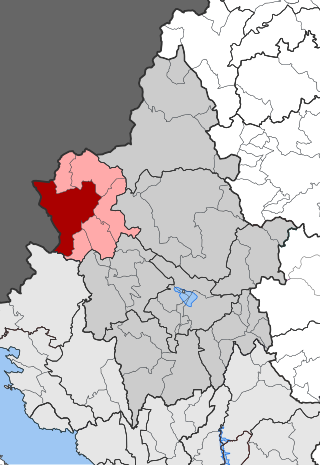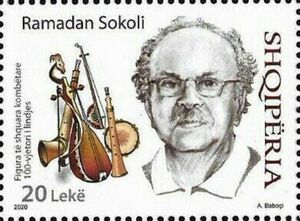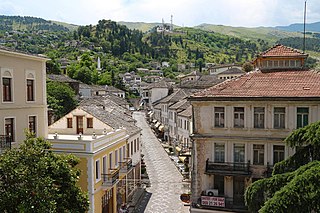
Polyphony is a type of musical texture consisting of two or more simultaneous lines of independent melody, as opposed to a musical texture with just one voice (monophony) or a texture with one dominant melodic voice accompanied by chords (homophony).

The Aromanians are an ethnic group native to the southern Balkans who speak Aromanian, an Eastern Romance language. They traditionally live in central and southern Albania, south-western Bulgaria, northern and central Greece and North Macedonia, and can currently be found in central and southern Albania, south-western Bulgaria, south-western and eastern North Macedonia, northern and central Greece, southern Serbia and south-eastern Romania. An Aromanian diaspora living outside these places also exists. The Aromanians are known by several other names, such as "Vlachs" or "Macedo-Romanians".

Resen is a town in southwestern North Macedonia, with just under 9,000 inhabitants. Resen is approximately equidistant between Bitola and Ohrid. The town rises 880 metres above sea level and is situated near Lake Prespa. Resen is the only town in the Prespa Lake area and is the seat of Resen Municipality.

Delvinaki is a former municipality in the Ioannina regional unit, Epirus, Greece. Since the 2011 local government reform, it is part of the municipality Pogoni, of which it is a municipal unit. The municipal unit has an area of 255.8 km2, the community 54.8 km2. In 2011 its population was 772 for the village and 2,540 for the municipal unit. Delvinaki is part of the traditional area of Pogoni.
The music of Epirus, in Epirus, northwestern Greece, present to varying degree in the rest of Greece and the islands, contains folk songs that are mostly pentatonic and polyphonic, characterized as relaxed, gentle and exceptionally beautiful, and sung by both male and female singers.
Pogon, is a former commune in the Gjirokastër County, southern Albania. At the 2015 local government reform it became a subdivision of the municipality Dropull. The population at the 2011 census was 432. It consists of seven villages which are mostly Greek speaking: Poliçan; Skore; Hllomo; Sopik; Mavrojer; Çatistë and Selckë of which Poliçan is the administrative center. The administrative unit of Pogon is inhabited by ethnic Greeks.
The Dance of Osman Taka ; Greek: Οσμαντάκας or Σαμαντάκας) is a traditional dance in Albania and Greece. In Albania it is mainly danced by Cham Albanians. The dance bears the name of Osman Taka, a 19th-century Muslim Cham Albanian guerilla fighter who fought against Ottoman forces. It is a famous variation from the Albanian Cham repertoire of the older Çamçe dance.
The Song of Çelo Mezani is an Albanian polyphonic folk song. It is considered to be the best-known Cham Albanian song. The song increased the awareness in Albania about the Chameria region and its history.
Kastri is a town in Thesprotia, Epirus, Greece. The local church is dedicated to Saint George.

Vajtim or Gjëmë is the dirge or lamentation of the dead in the Albanian custom by a group of men or a woman or a group of women. Cries have now become extinct both in the Islamic and Christian Albanian Population, except in some parts Northern Albania and Kosovo as well as in parts of North Macedonia such as Zajas and Upper Reka, where they exist in a very diminished form.
Neço Muko (October 21, 1899 – 1934), also known as Neço Muko Himarjoti, was an Albanian singer and composer. His musical style created a new genre of Albanian iso-polyphony music called avaz himariot, or avaz himariotçe, that became identified with the music of his home region Himarë.

Ramadan Sokoli was an Albanian ethnomusicologist, musician, composer and writer. He is regarded as one of the most distinguished scholars of the Albanian and Balkan music.

Gjirokastër National Folk Festival is an artistic festival taking place every five years at Gjirokastër Castle in Gjirokastër, southern Albania. The festival was first held in 1968 and is regarded as the most important event in Albanian culture. The festival showcases Albanian traditional music, dress and dance from Albania, the diaspora, and Albanian inhabited lands throughout the Balkans and Southern Italy. The Gjirokastër Festival followed the tradition of the Folklore Festivals started in Tirana in 1949.
Deropolitissa is a Greek polyphonic folk song, popular in the region of Dropull, southern Albania. It is also sung by the rest of the Greeks in Albania, as well as in parts of Greece.

Iso-Polyphony is a traditional part of Albanian folk music and, as such, is included in UNESCO's intangible cultural heritage list.

Gjirokastër is a city in southern Albania and the seat of Gjirokastër County and Gjirokastër Municipality. It is located in a valley between the Gjerë mountains and the Drino, at 300 metres above sea level. Its old town is a UNESCO World Heritage Site, described as "a rare example of a well-preserved Ottoman town, built by farmers of large estate". The city is overlooked by Gjirokastër Fortress, where the Gjirokastër National Folklore Festival is held every five years. It is the birthplace of former Albanian communist leader Enver Hoxha, and author Ismail Kadare.

Southern Albania is one of the three NUTS-2 Regions of Albania.
Mravalzhamieri is a Georgian folk song, the title and the one-word text of which can be translated as "[may you live] a long life". It is a popular and widespread toasting song, with dozens of different versions from the countryside of both eastern and western parts of Georgia. There are also several variants of "urban" Mravalzhamieri, originally from Tbilisi. Mravalzhamieri is typically sung in three-voice polyphony, in which two highly improvised melodic parts are developed on the background of a pedal drone in a free metre. The Mravalzhamieri version from the region of Kakheti, and that known as "urban" (k'alak'uri) were inscribed on the Intangible Cultural Heritage of Georgia list in 2013. Mravalzhamieri is also a Georgian name of the Christian chant Polychronion.
Aromanian music is the music characteristic of the Aromanians. The Aromanians are an ethnic group scattered throughout the Balkans, living in Albania, Bulgaria, Greece, North Macedonia, Romania and Serbia. Aromanian music has received influence from the music of other ethnic groups of the Balkans, such as that of the Albanians, Bulgarians, Greeks, Macedonians, Romanians and more. However, it has developed throughout history its own distinctive features and peculiarities that set it apart from other Balkan music genres, and has also influenced the music of the previously mentioned peoples.

The Battle of Mashkullorë took place between Albanian rebel forces under the command of Çerçiz Topulli and the Ottomans.













